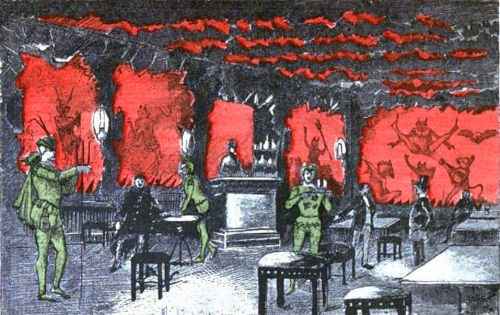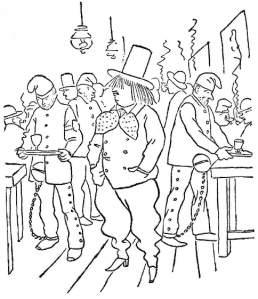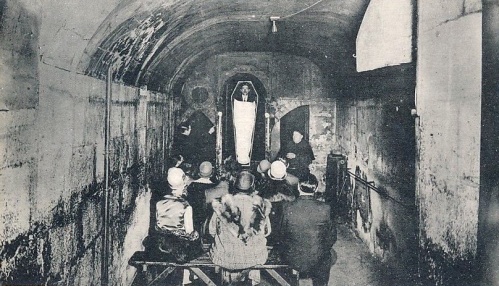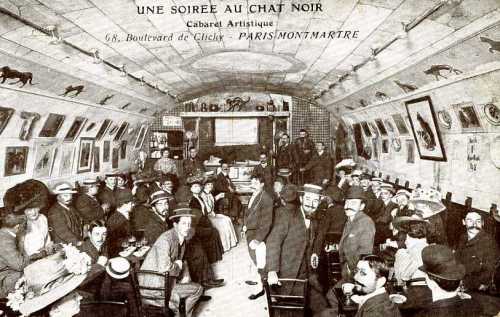 Because they traveled quite a bit musicians must have made up a notable percentage of early patrons of public eating places. It’s easy to imagine them playing a few tunes in return for their dinner, but if this happened I’ve found no trace of it. The first mention of music I’ve discovered was in 1866, in a description of a small French restaurant in New York with an oyster-shell framed alcove where “sometimes a boy with a violin will seem to afford music to the feast.”
Because they traveled quite a bit musicians must have made up a notable percentage of early patrons of public eating places. It’s easy to imagine them playing a few tunes in return for their dinner, but if this happened I’ve found no trace of it. The first mention of music I’ve discovered was in 1866, in a description of a small French restaurant in New York with an oyster-shell framed alcove where “sometimes a boy with a violin will seem to afford music to the feast.”
Note the negatively tinged words “seem to afford.” Throughout history there have been plenty of critics of musical “din” in restaurants.
 Music in restaurants was apparently a continental custom that migrated to these shores. At first it was highly associated with German restaurants such as Lauber’s at the 1876 Centennial Exhibition in Philadelphia. But by the late 1890s musical accompaniment with dinner became quite popular and all kinds could be found. “Wild” gypsy music as was played at NYC’s Café Boulevard was a favorite at Hungarian restaurants. Such places were known for their bohemian atmosphere — Why, people even talked to strangers! Later in the evening, the combined effect of food, wine, beer, and strolling musicians would have everyone singing choruses.
Music in restaurants was apparently a continental custom that migrated to these shores. At first it was highly associated with German restaurants such as Lauber’s at the 1876 Centennial Exhibition in Philadelphia. But by the late 1890s musical accompaniment with dinner became quite popular and all kinds could be found. “Wild” gypsy music as was played at NYC’s Café Boulevard was a favorite at Hungarian restaurants. Such places were known for their bohemian atmosphere — Why, people even talked to strangers! Later in the evening, the combined effect of food, wine, beer, and strolling musicians would have everyone singing choruses.
Orchestras of young women were also popular. In Boston, D. S. McDonald’s on Tremont Street served dainty chafing dish specials such as Lobster a l’Americaine and Oyster a la Poulette en Blazer to the tunes of such a group. “This is a touch of Bohemia right in the heart of Boston,” proclaimed a 1903 advertisement.
American restaurant-goers of the turn of the century were evidently longing for the music of exotic others to invigorate and entertain them. On the West coast that often meant Hawaiian hulas. Everywhere else it meant the music of African Americans, especially ragtime.
The naysayers pleaded for quiet with their dinners. Articles in 1904 and 1905 issues of Town and Country, noting that potted palms and Hungarian bands expressed “the spirt of the age,” nonetheless complained that even the Third Avenue Delmonico’s had become “a hall of artificial palms, red paper, gilding and ragtime.”
Some hoped the early, pre-WWI tea room would provide a haven from the “garishness of strong lights, deafening music,” and restless thrill seekers found at the average restaurant. Instead music spread everywhere. Chinese restaurants installed Chinese orchestras which played all the latest rags. Even cafeterias joined the bandwagon.
 It wouldn’t be long before clever minds figured out how to automate music in cafes and restaurants. At NYC’s Kalil’s in 1909 recorded voice of Caruso and other famous singers could be played on the Victor Auxetophone loudly enough to be accompanied by a live orchestra. The jukebox would not be far behind. In 1927 an advertisement advised cafeteria owners that the colorful Electramuse stimulated people “to have a good time – to spend MORE money!”
It wouldn’t be long before clever minds figured out how to automate music in cafes and restaurants. At NYC’s Kalil’s in 1909 recorded voice of Caruso and other famous singers could be played on the Victor Auxetophone loudly enough to be accompanied by a live orchestra. The jukebox would not be far behind. In 1927 an advertisement advised cafeteria owners that the colorful Electramuse stimulated people “to have a good time – to spend MORE money!”
But jukeboxes ran afoul of polite society in short order. They were popular in teen hangouts – and that was part of the problem. Adults shunned these cafes, and neighbors complained about loudness. Fights broke out over musical selections. The jukebox took on associations of low life, not helped one bit by stories like the one that appeared in 1954 about a feuding North Carolina drive-in restaurant operator blasting super-amplified “Shake, Rattle and Roll” at an evangelical meeting across the street. The final straw for the jukebox was its takeover by racketeers.
Muzak fared much better in the restaurant industry than did jukeboxes. It started operation in NYC in 1936 with 40 restaurants as clients. Among its early customers were the dining room in the Algonquin Hotel and the Kungsholm Swedish restaurant on E. 55th Street. At first limited to large cities, technical advances in 1954 permitted Muzak franchises to spread to smaller towns throughout the country.
Today we have the full panoply of music. Rarely do we hear orchestras, but string quartets, harpists, strolling musicians, and canned music are plentiful. Even jukeboxes have been scrubbed clean of their dark past to the delight of patrons of retro diners.
© Jan Whitaker, 2012

















 It's great to hear from readers and I take time to answer queries. I can't always find what you are looking for, but I do appreciate getting thank yous no matter what the outcome.
It's great to hear from readers and I take time to answer queries. I can't always find what you are looking for, but I do appreciate getting thank yous no matter what the outcome.


